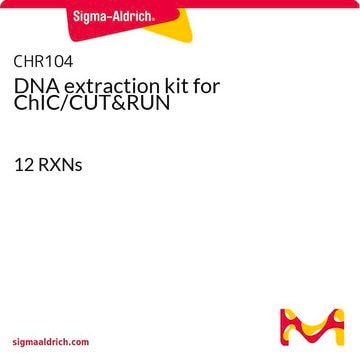11696505001
Roche
Agarose Gel DNA Extraction Kit
kit of for up to 100 reactions
Sinónimos:
agarose
Iniciar sesiónpara Ver la Fijación de precios por contrato y de la organización
About This Item
UNSPSC Code:
41105500
Productos recomendados
Categorías relacionadas
General description
By combining agarose gel electrophoresis and extraction, you can easily concentrate dilute, aqueous DNA solutions. After processing with the kit, the DNA can be recovered in a volume of 20 to 50 μL. Isolated DNA fragments are free of inhibitors that could affect common downstream procedures. For example, recovered DNA can be efficiently ligated into cloning vectors or labeled to high specific activity. Restriction digests proceed without inhibition.
For the elution of DNA fragments from agarose gels.
The Agarose Gel DNA Extraction Kit provides convenient isolation of high-quality DNA in large amounts.
The Agarose Gel DNA Extraction Kit provides convenient isolation of high-quality DNA in large amounts.
Application
Agarose Gel DNA Extraction Kit has been used to extract full-length (CHRNA_v2) and shortest (CHRNA_v3) amplicons from agarose gels.
The Agarose DNA Extraction Kit efficiently isolates both small and large DNA fragments from standard or low melting point agarose. Recovered DNA fragments are suitable for:
- Ligation and transformation
- Enzymatic restriction
- Random primed or nick translation labeling methods
- Sequencing
- PCR/long PCR
- Cloning
- Concentrate dilute nucleic acid solutions
Features and Benefits
- Quick and simple.
- Combine with different agaroses and buffer systems.
- Purify efficiently.
- Isolate large DNA fragments without shearing.
- Isolate oligonucleotides >=20 bp.
- Avoid enzymatic inhibition.
Components
- Silica Matrix, for 100 standard reactions
- Solubilization Buffer
- Nucleic Acid Binding Buffer
- Wash Buffer
Quality
DNA Molecular Weight Marker II is separated in a 0.8% agarose gel and the 546-, 2,322-, and 6,557 bp fragments are isolated with the kit components. The expected amount of DNA is recovered for each fragment. Depending on parameters such as fragment length, preparation, and purity of the applied DNA, up to 80% recovery is achieved. DNA fragments are digested with restriction enzymes. No inhibition of DNA digestion is observed.
Preparation Note
A solubilization buffer containing a chaotropic salt (sodium perchlorate) dissolves an agarose gel slice that contains a DNA fragment. In the presence of the chaotropic salt, the DNA fragment binds selectively to silica matrix. The DNA remains bound while a series of rapid wash-and-spin steps remove contaminating small molecules. Finally, low-salt elution removes the DNA from the silica matrix. The process does not require DNA precipitation, organic solvent extractions, or extensive handling of the DNA.
Other Notes
For life science research only. Not for use in diagnostic procedures.
signalword
Danger
hcodes
Hazard Classifications
Acute Tox. 4 - Eye Irrit. 2 - Ox. Liq. 1 Oral - STOT RE 2
Storage Class
5.1A - Strongly oxidizing hazardous materials
wgk_germany
WGK 1
flash_point_f
does not flash
flash_point_c
does not flash
Certificados de análisis (COA)
Busque Certificados de análisis (COA) introduciendo el número de lote del producto. Los números de lote se encuentran en la etiqueta del producto después de las palabras «Lot» o «Batch»
¿Ya tiene este producto?
Encuentre la documentación para los productos que ha comprado recientemente en la Biblioteca de documentos.
Los clientes también vieron
Seiya Kanno et al.
STAR protocols, 3(2), 101439-101439 (2022-06-10)
We describe a protocol for a live-cell luciferase assay system for continuously monitoring fibroblast growth factor (FGF) signal disruption in human-induced pluripotent stem cells (iPSCs). Signal disrupting effects of chemicals are used as an indicator to evaluate toxicity. The assay
Zhongchun Tong et al.
Experimental and therapeutic medicine, 14(6), 5491-5496 (2017-12-30)
A high prevalence of Enterococcus faecalis (E. faecalis) is observed in teeth with root canal treatment failures. Clustered regularly interspaced short palindromic repeats (CRISPR) are widely distributed in prokaryotes that have adaptive immune systems against mobile elements, including pathogenic genes.
Joris van Arensbergen et al.
Nature biotechnology, 35(2), 145-153 (2016-12-27)
Previous methods to systematically characterize sequence-intrinsic activity of promoters have been limited by relatively low throughput and the length of the sequences that could be tested. Here we present 'survey of regulatory elements' (SuRE), a method that assays more than
Cholinergic Receptor Nicotinic Alpha 5 (CHRNA5) RNAi is associated with cell cycle inhibition, apoptosis, DNA damage response and drug sensitivity in breast cancer
Koker SC, et al.
PLoS ONE, 13(12), e0208982-e0208982 (2018)
Sahika Cingir Koker et al.
PloS one, 13(12), e0208982-e0208982 (2018-12-14)
Cholinergic Receptor Nicotinic Alpha 5 (CHRNA5) is an important susceptibility locus for nicotine addiction and lung cancer. Depletion of CHRNA5 has been associated with reduced cell viability, increased apoptosis and alterations in cellular motility in different cancers yet not in
Nuestro equipo de científicos tiene experiencia en todas las áreas de investigación: Ciencias de la vida, Ciencia de los materiales, Síntesis química, Cromatografía, Analítica y muchas otras.
Póngase en contacto con el Servicio técnico









